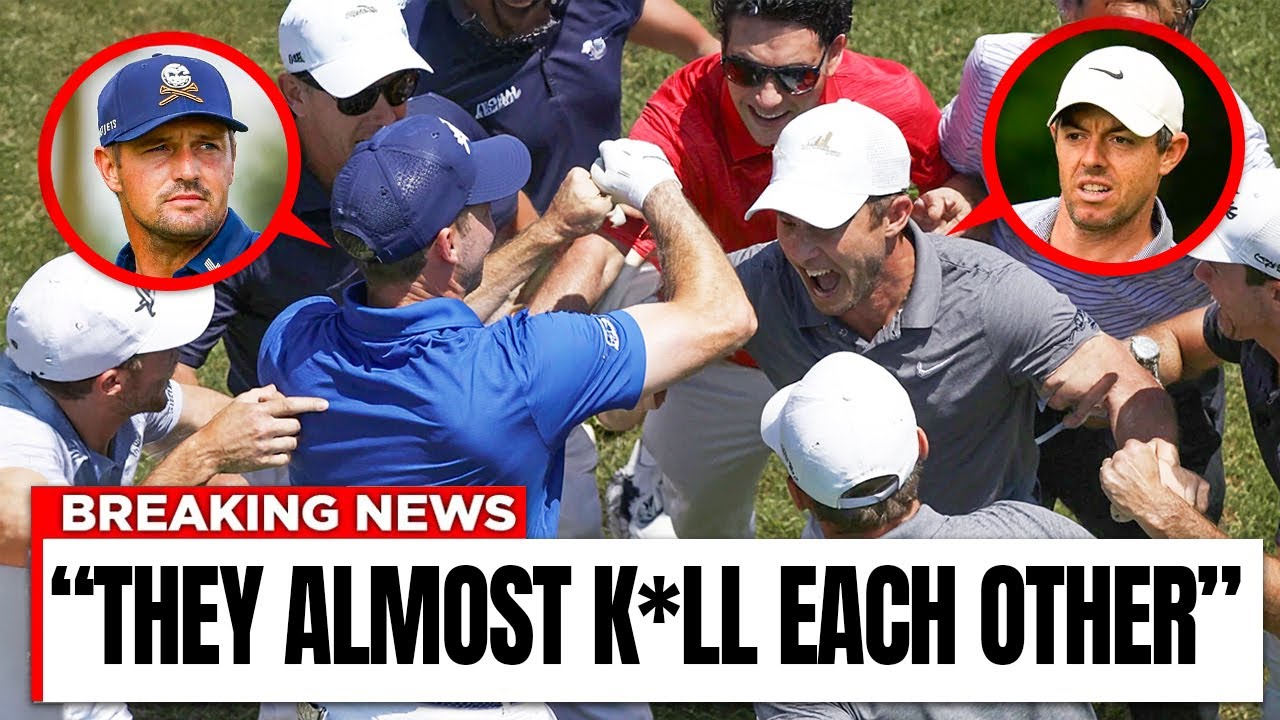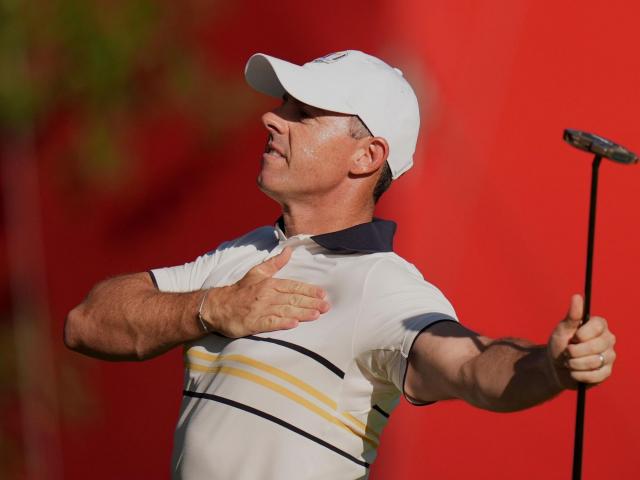10 Things You Didn’t Know About The 2025 Ryder Cup
The 2025 RDER Cup wasn’t just a golf tournament. It was a battleground of secrets, chaos, and history rewritten in real time. What happened at Beth Page Black pushed the limits of the sport and maybe reality itself. But there’s far more beneath the scoreboards and headlines. And I’ve uncovered every strange hidden twist you weren’t supposed to see. The first red flag was the calendar. The RDER Cup ran from September 26th to 28th, but the timeline squeeze before that, that was the real story. Organizers chopped down the usual prep days to make room for the security bubble that surrounded this year’s edition. Imagine hundreds of volunteers, players, and staff all jammed into a tighter than usual window. It wasn’t just stress, it was gridlock disguised as efficiency. Beth Page Black, a public course with state park DNA, doesn’t behave like your pampered country club fairway. This meant that walkways, broadcast towers, and even escape routes had to be completely redrawn. Suddenly, every inch of the venue was under surveillance. Every crowd movement monitored. The ropes weren’t just boundaries. They were crowd control lines. And here’s the kicker. That logistical compression made the crowd energy unhinged. Small delays ballooned into viral moments, like a spectator shouting mid- swing or a beer exploding into an unplanned baptism. Beth Paige’s layout turned every tiny disruption into theater, the kind that bled straight into Tik Tok timelines within minutes. The date wasn’t trivia. It was the first domino. If you thought this was just another week of green jackets and polite applause, think again. Beth Paige Black was weaponized. The setup team pulled off a silent act of sabotage. the kind that only pros feel but fans love watching. Tea boxes were pushed so far back that one par three looked like a bad dare. Bunker lips grew taller, escape angles vanished, and fairways shrank into cruel funnels. It wasn’t just a course. It was a psychological riddle dressed up as golf greens. Oh, they were sinister. Crews secretly adjusted speeds from hole to hole. Not enough for cameras to notice, but enough to scramble putting rhythms. Players looked like amateurs missing three-footers when in reality they were victims of turf trickery. It was brilliant, diabolical, and according to a few insiders, completely intentional. The captains, they used it like a chessboard. Pair the methodical putter with the accurate wedge player, and you could neutralize a bomber who depended on rollouts. Every forsome became a duel of data and nerve. On TV, it looked like luck. On the course, it was silent warfare and spikes. Then came the envelope incident. Victor Havlin’s neck gave out and the universe said, “Let’s make it weird.” That triggered the obscure envelope rule. Captain secretly pre-select one player for a phantom match in case of a lastminute withdrawal. When Havlin pulled out, the envelope opened and boom, an automatic half point on the board before a single swing on Sunday. Sounds harmless. It wasn’t. That half point rewired the entire day’s math. Captains had to reshuffle pairings. Players lost rhythm. And gamblers everywhere screamed at their spreadsheets. For the first time in years, strategy bent to bureaucracy. The irony? The envelope rule was supposed to simplify chaos. Instead, it became the chaos. Analysts are now demanding reform, claiming the entire Rder Cup momentum turned on a formality buried in paperwork. And honestly, they might be right. You could feel it before you saw it. The motorcade hum, the radio silence, the sudden tightening of every security line. Because yes, Donald Trump, the sitting president of the United States, showed up on day one of the RDER Cup, a first in the tournament’s entire century long history. The crowd thought they were there to see Rory and Spe. Instead, they got an unannounced state visit dressed up as a golf cameo. The ripple effect, absolute logistical bedum, secret service grids carved through Long Island’s fairways like invisible fortresses. Entry gates opened early. Fans queued for hours and checkpoints choked traffic until the tea times blurred. The irony: some spectators missed opening shots because of security delays. Meaning the presidential cameo literally delayed the president’s favorite thing, television coverage. But the strangest part wasn’t the politics, it was the noise shift. The moment the president arrived, entire sections of the crowd morphed into chanting pockets of patriotism and protest. Suddenly, golf had the energy of a campaign rally. Every swing was met with applause or sarcasm, depending on which fairway you stood on. It was pure spectacle. Beth Paige didn’t host the Ryder Cup that day. It hosted Democracy in a Golf Cart. USA. President Trump getting way more than a golf clap at the Ryder Cup yesterday. But as the Trump administration hits hole-in-one after hole-in-one, Democrats seem to be falling into a sand trap with new all-time low favorability rating. Beth Paige is famous for being loud. But this was unholy. Forget polite applause. We’re talking beer showers, squeaky rubber ducks, and chants that would make a soccer stadium blush. Fans didn’t just cross lines, they redrew them, spray painted them, and danced on them. At one point, a player’s spouse was hit by a tossed drink. At another, a European putt was drowned out by a wave of synchronized mock coughing. Psychologically, it was devastating. Sports scientists actually studied the footage and found that sustained auditory hostility can trigger micro tension in a player’s swing. Yes, literal measurable stress in the muscles. The result? Shorter drives, quicker tempo, bad reads. It wasn’t just banter. It was weaponized chaos and that’s what flipped matches. Players didn’t crumble from fatigue or form. They cracked from noise fatigue. Captains noticed. By the final day, the US team tried to use crowd control as an unofficial tactic, steering certain players away from the problem holes, but it was too late. Beth Paige had turned into a psychological war zone, and every spectator was a combatant. Now, let’s talk screens, because this Ryder Cup didn’t just split continents. It split narratives. In Europe, the ratings shattered records. Fans stayed up through the night. Every clip dissected, every fist pump immortalized. But in the US, crickets. The linear TV numbers were weirdly soft, leaving the viral conversation dominated by European broadcasters. That imbalance created a digital fever dream. Social feeds were flooded with European highlight reels, underdog arcs, camaraderie montages, team of destiny edits. While American fans saw a completely different story. Selective comebacks, heroic misses, defiant losses, two RDER cups, one internet. By the time the trophy was lifted, public memory had already forked into alternate timelines. Europeans celebrated a masterpiece of unity. Americans mourned a series of unlucky bounces. The media didn’t just report it, they rewrote it. And that’s the new world order of sports storytelling. Whoever trends first wins the history books. While the crowd screamed and the cameras zoomed in on the chaos. Behind the ropes, a different war was being fought. The war of pairings. The captains Keegan Bradley and Luke Donald weren’t just managing egos. They were running spy ops in polos. The secret weapon, the envelope strategy. A move so rarely used it feels like folklore. Bradley’s envelope wasn’t a backup. It was a trapoor. Donald’s late night adjustments weren’t intuition. They were analytics. Captains huddled in mobile command centers with data sheets, video replays, and even noise mapping reports of which holes had the rowdiest fans. That’s right. Pairing choices were influenced not just by skill, but by crowd geography. One player’s drive pattern intersected with a notoriously hostile grandstand. Swap him out. It was chess played in 3D under lights with adrenaline and hecklers. Bradley reportedly changed two Saturday night pairings based on how certain players reacted to practice range heckles. Donald countered with precision, pairing calm, calculated players in those exact zones. To viewers, it looked like captaincy. In reality, it was psychological espionage. And in the final tally, those moves, invisible to most, likely decided entire matches. Golf events always attract side stories. But Beth Pa’s background noise was a full novel. The week started with powerline issues that delayed security scans, moved to motorcade route reshuffles, and ended with hospitality drama that could fill a Bravo reunion episode. The VIP terraces, for instance, were restocked with influencers and micro celebrities instead of the usual golf aristocracy, and that changed the crowd tone completely. The influencers weren’t whispering between swings, they were vlogging. Their energy bled into nearby stands and suddenly regular fans mimicked the noise patterns they saw online. The grand stands became part concert, part content farm. Even rituals like certain players touching the first tea marker got mimicked in the bleachers. By day three, golf wasn’t being watched. It was being performed. And that’s where the Rder Cup crossed into pop culture chaos. Between celebrity cameos, micro scandals, and memes mid round, Beth Paige turned into the Coachella of competitive golf where everyone wanted their 5 seconds on screen and decorum was as extinct as par. Now, let’s zoom in. Not on the players, but the holes. The secret villain of the week wasn’t a golfer. It was wind. Subtle gusts, pin placements, and bunker refits combined into what stat nerds now call variance volatility. Translation: A handful of holes swung matches like pendulums. Morning players faced a par4 playing two strokes harder. Afternoon players found it tame. Those micro shifts cascaded through the leaderboard, giving Europe the hidden advantage before Sunday even began. The public saw it as momentum. Analysts saw math. Beth Pa’s routing punished millimeters of error. And when paired with manipulated stimp readings, the course itself became Europe’s 13th man. Match play magnifies everything. One bad bounce becomes a lost point. And when three or four holes tilt like loaded dice, it’s not drama, it’s destiny. Beth Paige didn’t just test skill, it engineered chaos. And when the dust settled, Europe walked away with the cup 15-13 and America walked away with questions. But the real story isn’t the score line. It’s that this RDER Cup was less about golf and more about control. Who had it? Who lost it? And who realized too late that they never really did. The presidential cameo, the envelope rule, the crowd madness, the manipulated course, all collided to create a tournament where the off-c course forces became the headline act. Analysts will call it the most studied RDER Cup in modern history. But fans, they’ll remember it for the noise, the memes, and the moments where sport turned into spectacle. Beth Paige Black wasn’t conquered. It was survived. And for years to come, this cup will be whispered about not as a sporting contest, but as a cautionary tale of what happens when precision, politics, and pandemonium share the same tea time. So, there you have it. The Ryder Cup that broke the rules and maybe the format. It wasn’t just golf. It was Chaos Theory with Caddies. From secret envelopes to rogue presidents, Beth Page will echo through golf history as the moment the sport went fully cinematic. Subscribe. The next meltdown is already warming up.
10 Things You Didn’t Know About The 2025 Ryder Cup







